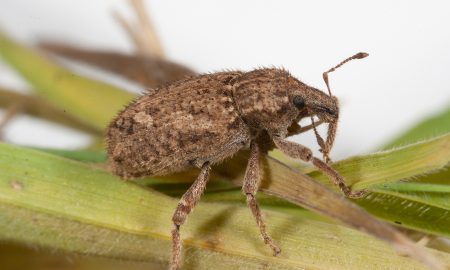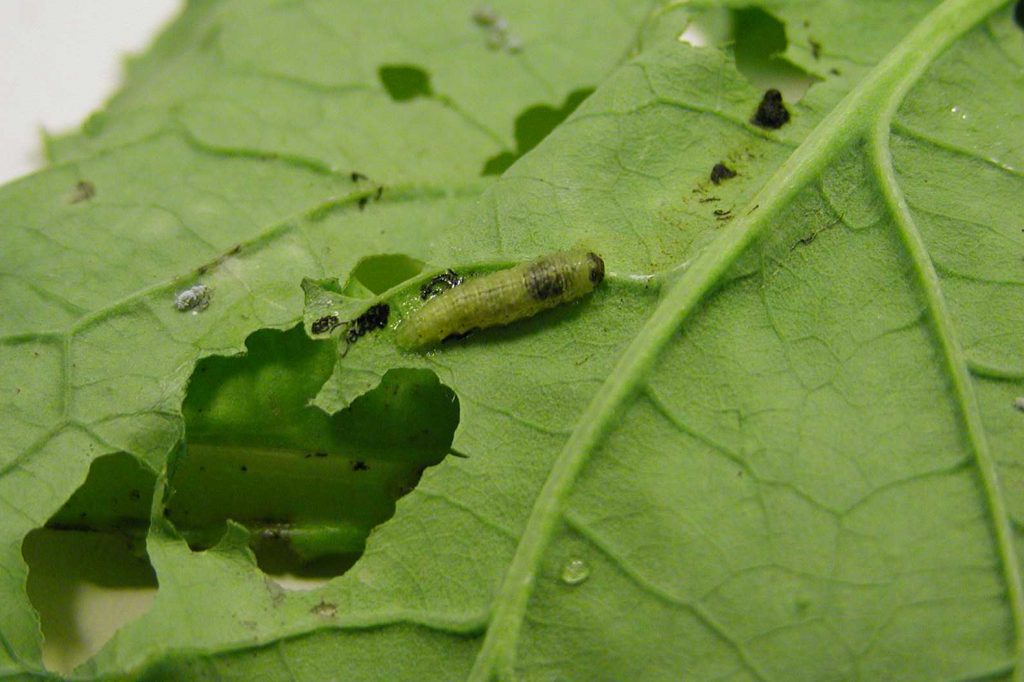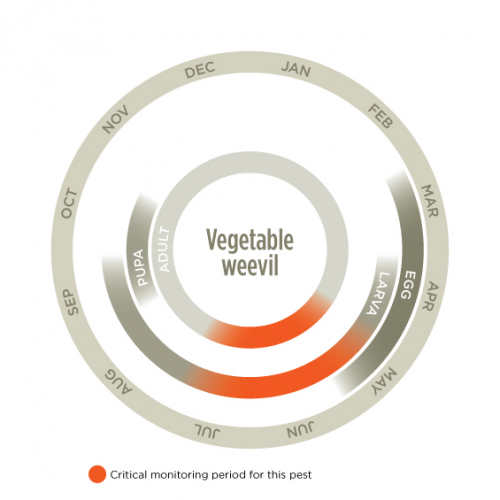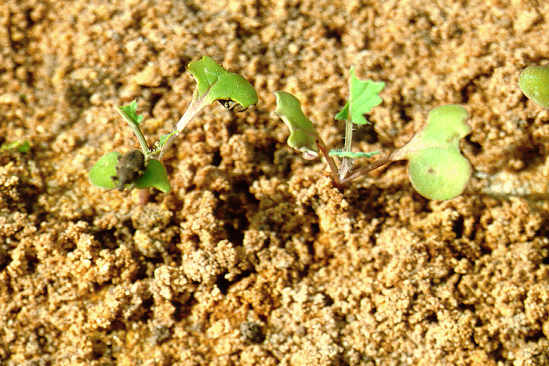Vegetable weevil
Listroderes difficilis
Other common names
Brown vegetable weevil

Photo by Andrew Weeks, Cesar Australia
Summary Top
The vegetable weevil is a sporadic pest and widely distributed across all Australian states. Adults have grey-brown bodies, a prominent snout and a distinctive pale ‘V’ on their back. Both adults and larvae are pests of establishing canola, often where weeds are present. Vegetable weevils do not typically feed below ground. More damage usually occurs around crop edges or where host weeds are present. Vegetable weevils can be managed by reducing weed host plants and using a border spray at crop emergence.
Occurrence Top
The vegetable weevil originated in South America, and is now a sporadic pest that is widely distributed throughout Australia, occurring in all states and territories.
Description Top
Weevils are the largest family of beetles. There are over 6,000 described species in Australia.
Adult vegetable weevils (sometimes called the brown vegetable weevil) are 8 mm long, greyish-brown in colour and have a noticeable and inconspicuous V-shape marking (grey brown) on the wing covers near the rear of the body. Adults have a prominent snout and small pointed process towards the rear of each wing cover. Vegetable weevils are flightless. Larvae are legless and either yellow to green, or cream in colour with an orange-brown head. They have a curved body and can grow up to 13 mm long.


Lifecycle Top
Vegetable weevils have one generation per year, with adults laying up to several hundred eggs on plants, surface litter or soil from mid March until September. Larvae feed on leaves of plants and pupate in the soil. Adults emerge between September and October, but during summer and early autumn adults undergo a diapause period and are inactive in the soil.

Behaviour Top
Larvae feed during the night on developing plants and shelter in the soil during the day. Adults emerge in spring, feed at night and shelter during the day. Adults undergo a diapause period and are inactive in the soil during summer. Because they are flightless insects, natural dispersal can be slow.
Similar to Top
It is difficult to distinguish between the larval stages of weevil species. Larval stages are legless (apodous), maggot-like in shape and may be confused with fly larvae, which are also legless. Unlike weevils, most fly larvae do not have a well-defined head capsule. Adults and larvae are similar to the grey-banded leaf weevil. Adults are also confused with spotted vegetable weevil.
Crops attacked Top
Canola and other brassica plants. Capeweed is a common weed host.
Damage Top
Canola seedlings may be retarded or killed completely as a result of feeding. Both adults and larvae are capable of chewing sections out of the leaves. This species does not typically feed below ground. Vegetable weevils cause damage that includes chewing of leaf edges, or seedlings eaten down to ground level. More damage usually occurs around crop edges or where host weeds are present.

Both larval and adult vegetable weevils can seriously damage the above-ground parts of seedlings, in particular canola and other brassica plants.
Monitor Top
Monitor canola crops at establishment and the seedling stage during autumn and winter. Focus on crop edges in particular. Searches for adults are best undertaken at night, as this is when vegetable weevils are most active. During the day, search for weevils around the base of damaged plants or hiding under trash. Larvae may be just below the soil surface or found in the terminal growth. Pitfall traps are an effective technique to assess the abundance of weevils.
Economic thresholds Top
There are no established economic thresholds for this pest.
Management options Top
Biological
There are no known predators, parasites or pathogens that effectively control vegetable weevils.
Cultural
Reduce weed host plants, particularly capeweed, prior to planting. This can be achieved through grazing, cultivation or the use of herbicides. Rotations involving non-host plants, or a long weed-free fallow prior to planting, will minimise both adult and larval numbers. Sowing canola crops away from paddocks known to contain vegetable weevils reduces the risk of invasion.
Chemical
Several insecticides are registered for control of vegetable weevils in broadacre crops, including alpha-cypermethrin, bifenthrin, chlorpyrifos and esfenvalerate. Effective control can often be achieved with a border spray at crop emergence. Blanket sprays are often unnecessary for effective vegetable weevil control.
Damage by vegetable weevils can be reduced by reducing weed host plants and a border spray at crop emergence.
Acknowledgements Top
This article was compiled by Sandra Hangartner, Garry McDonald (cesar) and Paul Umina (cesar).
References/Further Reading Top
Bailey PT. 2007. Pests of field crops and pastures: Identification and Control. CSIRO Publishing, Melbourne, Australia.
Gu H, Fitt GP and Baker GH.2007. Invertebrate pests of canola and their management in Australia: a review. Australian Journal of Entomology 46: 231-243.
Henry K, Bellati J, Umina P and Wurst M. 2008. Crop Insects: the Ute Guide Southern Grain Belt Edition. Government of South Australia PIRSA and GRDC.
Micic S. 2005. Identification and cultural control of insect and allied pests of canola. Bulletin 4650. Department of Agriculture Western Australia, Perth.
Micic S, Hoffmann AA, Strickland G, Weeks AR, Bellati J, Henry K, Nash MA and Umina P. 2008. Pests of germinating grain crops in southern Australia: an overview of their biology and management options. Australian Journal of Experimental Agriculture 48, 1560-1573.
| Date | Version | Author(s) | Reviewed by |
|---|---|---|---|
| February 2015 | 1.0 | Sandra Hangartner, Garry McDonald (cesar) and Paul Umina (cesar) | Bill Kimber (SARDI) |
What are PestNotes?
PestNotes are information sheets developed through a collaboration between Cesar Australia and the South Australian Research and Development Institute (SARDI). Copyright: © All material published in PestNotes is copyright protected by Cesar Australia and SARDI and may not be reproduced in any form without written permission from both agencies.
Disclaimer
The material provided in PestNotes is based on the best available information at the time of publishing. No person should act on the basis of the contents of this publication without first obtaining independent, professional advice. PestNotes may identify products by proprietary or trade names to help readers identify particular products. We do not endorse or recommend the products of any manufacturer referred to. Other products may perform as well as or better than those specifically referred to. Cesar Australia and PIRSA will not be liable for any loss, damage, cost or expense incurred or arising by reason of any person using or relying on the information in this publication. Any research with unregistered pesticides or products referred to in PestNotes does not constitute a recommendation for that particular use.

